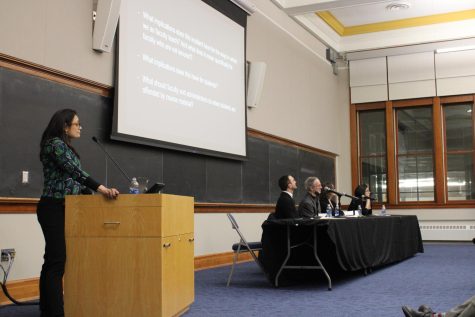Letter to the Editor: Professor Emeritus Aida Audeh
January 20, 2023
To the Hamline University Board of Trustees, January 19, 2023
I was a Professor of Art History at Hamline University for nearly two decades — from 2002-2021. During this time I was Hamline’s only full-time tenured faculty member in my field. I served as Chair of the Department of Studio Arts and Art History for more than 10 years and as administrative division head of Fine Arts and then Arts, Media, and Culture for a total of 4 years. I served on numerous committees at Hamline including Faculty Council, Faculty Council Handbook Committee, Faculty Personnel Committee (FPC), and Academic Affairs Committee (AAC). I was also a member of HU’s AAUP chapter for many years. In sum, I had long experience at Hamline in both faculty and administrative roles. I would still be at Hamline, teaching Art History, perhaps still chairing my department, had it not been for the Expedited Program Review (EPR) process of 2021 that eliminated the Art History major from HU’s curriculum. With that, under our Faculty Handbook, my tenured position was also at risk of relocation to another department, reassignment to other teaching duties, and/or elimination. Faced with this wretched uncertainty, I made the decision to take early retirement at the relatively young age of 58.
From my vantage point as emeritus professor and retiree, I have watched over the past few months as Hamline became embroiled in a scandal over an Art History class (ARTH 1100 World Art) that I had introduced to the curriculum in recent years as an online asynchronous introductory level course designed primarily for students seeking general education credits in Fine Arts and/or Humanities. I have closely followed the various accounts in The Oracle and in the national and international press in this regard.
My feelings about this are somewhat conflicted in that while I support the adjunct instructor’s decision to show the images in question as proper to art historical pedagogy, I can also understand student concern in relation to personal faith. I bemoan Hamline administration’s handling of the situation. But most of all I am dismayed that as a result of the controversy ensuing in the press, this unfortunate situation is now associated so strongly with Art History at Hamline in the minds of students, administrators and the public.
I invested 10 years of my life in graduate school obtaining my MA and PhD in Art History in order to join the professoriate. I invested nearly 20 years of my life at Hamline, as the only tenured Art Historian Hamline has known in recent years (if there had been previous tenured Art Historians at Hamline I’d appreciate having this information for my own records). I built the curriculum for the major and minor over a number of years, taught courses at all levels from introductory, to intermediate, to advanced, created special topics courses and first-year seminars (FYSems), and hired many adjunct instructors over the years to provide courses specific to their expertise to augment our offerings. I encouraged HU students to seek out additional Art History courses through the Associated Colleges of the Twin Cities (ACTC) consortium and to participate in research opportunities such as Summer Collaborative Undergraduate Research (SCUR) and National Conferences on Undergraduate Research (NCUR). I did the best I could with the resources available to me to sustain the Art History program at Hamline.
In all those years that I taught, I do not recall even one time when anyone suggested or demanded that I should refrain from showing particular works of art to students in my classes. To suggest or demand such a thing is tantamount to censorship and this is a very dangerous precedent, particularly in the arts. While I understand student concern, and the university’s desire to respond to it, censorship of any kind is far worse than any disruption a work of art might cause. Censorship is detrimental to education, to the exploration of knowledge, and to our growth as human beings. You’ve heard enough already about art being challenging by necessity, how learning is challenging as well. I need not repeat that here. But I will reiterate that when an institution begins suppressing creative arts, that slope becomes very slippery very quickly. It is also beyond the pale to censor speech —– whether in print or otherwise —– of a faculty subject matter expert.
I write to express my views here as a matter of public record, because I do not wish to see the Art History program I built reduced to a scandal in Hamline’s history and in public memory. I had some very fine students in my nearly 20 years at Hamline. Many majored or minored in Art History and some went on to graduate school in the field and now enjoy successful careers as faculty in universities, and as curators and researchers in museums and galleries. Some took the skills in writing and research they gained from their Art History major with me at Hamline and put them to good use in other fields. I am proud of my students, and proud of what I accomplished as Hamline’s Art Historian from 2002-2021. I believe Hamline made an error in eliminating the Art History program, as it is clear to me that classes that contextualize the visual arts within their historical period and culture of origin are still very much needed within the liberal arts curriculum. I wish Art History at Hamline to be remembered for the success it was, and for its continued legacy exemplified by its many successful alumni.
Aida Audeh, PhD
Professor Emeritus of Art History, Hamline University





Killer Marmot • Jan 23, 2023 at 12:28 am
The Oracle editors had a choice: activists or journalists.
They first chose journalists, then activists, and now back to journalists.
Good choice, although you could have done without the detour.